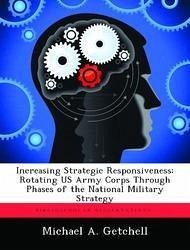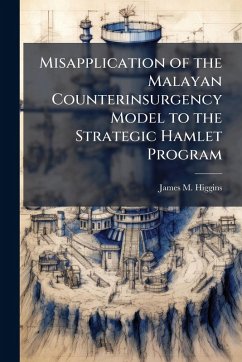
Increasing Strategic Responsiveness
Rotating US Army Corps Through Phases of the National Military Strategy
Versandkostenfrei!
Versandfertig in über 4 Wochen
15,99 €
inkl. MwSt.

PAYBACK Punkte
8 °P sammeln!
The purpose of this monograph is to answer the question: Can the Army increase its strategic responsiveness in order to narrow the current gap between Army capabilities and requirements? To arrive at an answer, this paper begins by examining complexity theory to provide the cognitive tools necessary to understand how systems interact with their environments. Chapter three examines the changes in the national security and military strategies in response to international and domestic factors over the last decade. It also assesses the impact these changes produced, an imbalance between Army requi...
The purpose of this monograph is to answer the question: Can the Army increase its strategic responsiveness in order to narrow the current gap between Army capabilities and requirements? To arrive at an answer, this paper begins by examining complexity theory to provide the cognitive tools necessary to understand how systems interact with their environments. Chapter three examines the changes in the national security and military strategies in response to international and domestic factors over the last decade. It also assesses the impact these changes produced, an imbalance between Army requirements and capabilities. Utilizing Martin Van Creveld's rules for enhancing command performance, chapter four explores alternative proposals that aim to close the gap between requirements and capabilities by increasing strategic responsiveness. While investigating the problem and potential solutions, it became clear that versatility is the key to reducing this gap. Versatility, the capacity to shift capabilities to meet requirements, is achieved by separating the force in time and purpose. However, without rotation of forces between missions, the force becomes agile and not versatile. In particular, the paper recommends the Army divide its overarching requirement to fight and win the nation's war into the three domains of the 1997 National Military Strategy (NMS) and establish semi-independent forces capable of dealing with each of these domains separately. It postulates a model that rotates balanced corps between the domains of shape, prepare, and respond. By rotating the force between the domains, the Army builds a versatile general-purpose force, increases its stability, and reduces the effects of a demanding OPTEMPO. The combined effect is a force with the increased strategic responsiveness required to narrow the ever-shifting gap between capabilities and requirements. This work has been selected by scholars as being culturally important, and is part of the knowledge base of civilization as we know it. This work was reproduced from the original artifact, and remains as true to the original work as possible. Therefore, you will see the original copyright references, library stamps (as most of these works have been housed in our most important libraries around the world), and other notations in the work. This work is in the public domain in the United States of America, and possibly other nations. Within the United States, you may freely copy and distribute this work, as no entity (individual or corporate) has a copyright on the body of the work. As a reproduction of a historical artifact, this work may contain missing or blurred pages, poor pictures, errant marks, etc. Scholars believe, and we concur, that this work is important enough to be preserved, reproduced, and made generally available to the public. We appreciate your support of the preservation process, and thank you for being an important part of keeping this knowledge alive and relevant.












